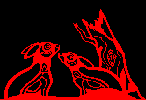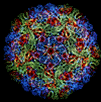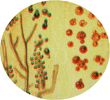| Microbial Metabolism |  |
| Readings | Presentations | Multiple Choice Quizzes | Key Terms | Questions | Updated 13/02/01 |
![]()
A strange thing has occurred in America.
I am not sure that it has
ever occurred before. The teachers wish to make learning easy.
They desire to peptonize and sweeten the food. Their little books
are soft biscuit for weak teeth, easy reading on great subjects;
but these books are filled with a pervading error; they contain
a subtle perversion of education. Learning is not easy but hard.
John Jay Chapman
Who am I? I studied the structure of antibodies and developed the first plausible model of the IgG molecule for which I received the Nobel Prize in 1972,
| Readings Microbial Metabolism | |||
 |
Baron
Medical Microbiology Chap 4 Bacterial Metabolism |
 |
Brock
9th Ed Biology of Microorganisms Chap4 Nutrition and Metabolism |
| Tortora:
Microbiology An Introduction Chap 5 Microbial Metabolism |
 |
Jacquelyn
Black 4th Ed Microbiology: Principles & Explorations Chap 5 Essential Concepts of Metabolism |
|
| Presentations | Slides | Web Animation | Download |
| Fermentation | |||
| Respiration | |||
| Electron Transport | |||
| Photosynthesis | |||
| Nutrients | |||
| DEFINE THE FOLLOWING KEY TERMS: | ||||
| metabolism | catabolism | anabolism | enzymes | substrate |
| turnover number | cofactor | coenzyme | Chemoheterotrophs | FAD |
| ADP | ATP | coenzyme A | Ribozymes | Oxidation |
| Reduction | Chemoautotrophs | anaerobe | electron transport chain | Glycolysis |
| Krebs Cycle | Cellular respiration | Fermentation | Embden Meyerhoff Pathway | saprophyte |
| chemiosmosis | aerobic respiration | proton pump | EnterDoudoroff Pathway | parasite |
| phototroph | anaerobic respiration | Anoxygenic phototrophs | Oxidative phosphorylation | NAD+ |
| Autotroph | Chemotroph | oxygenic phototrophs | Substrate Level phosphorylation | aerobe |
| photoautotrophs | photoheterotrophs | |||
![]()